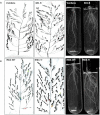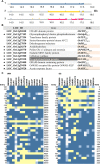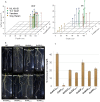Action of multiple intra-QTL genes concerted around a co-localized transcription factor underpins a large effect QTL
- PMID: 26507552
- PMCID: PMC4623671
- DOI: 10.1038/srep15183
Action of multiple intra-QTL genes concerted around a co-localized transcription factor underpins a large effect QTL
Abstract
Sub-QTLs and multiple intra-QTL genes are hypothesized to underpin large-effect QTLs. Known QTLs over gene families, biosynthetic pathways or certain traits represent functional gene-clusters of genes of the same gene ontology (GO). Gene-clusters containing genes of different GO have not been elaborated, except in silico as coexpressed genes within QTLs. Here we demonstrate the requirement of multiple intra-QTL genes for the full impact of QTL qDTY12.1 on rice yield under drought. Multiple evidences are presented for the need of the transcription factor 'no apical meristem' (OsNAM12.1) and its co-localized target genes of separate GO categories for qDTY12.1 function, raising a regulon-like model of genetic architecture. The molecular underpinnings of qDTY12.1 support its effectiveness in further improving a drought tolerant genotype and for its validity in multiple genotypes/ecosystems/environments. Resolving the combinatorial value of OsNAM12.1 with individual intra-QTL genes notwithstanding, identification and analyses of qDTY12.1has fast-tracked rice improvement towards food security.
Figures




References
-
- Land F. A. O. & Water Drought. (2013) at: http://www.fao.org/docrep/017/aq191e/aq191e.pdf Date of Access: 17/04/2015.
-
- O’Toole J. C. Drought resistance in crops with emphasis on rice in Adaptation of rice to drought prone environments (ed. International Rice Research Institute) 195–213 (IRRI, 1982).
-
- Jagadish S. V. K. et al. Genetic Advances in Adapting Rice to a Rapidly Changing Climate. J. Agron. Crop Sci. 198, 360–373 (2012).
-
- Salvi S. & Tuberosa R. To clone or not to clone plant QTLs: present and future challenges. Trends Plant Sci. 10, 297–304 (2005). - PubMed
MeSH terms
Substances
LinkOut - more resources
Full Text Sources
Other Literature Sources
Molecular Biology Databases

